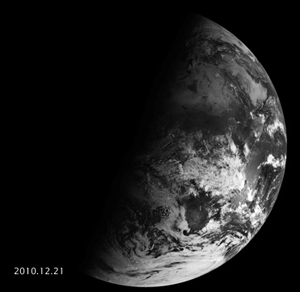At 09:05 UTC (05:05 Eastern US time) this morning, the position of the center of the Sun’s disk, moving south, crossed the celestial equator on the sky. For normal people, this means it was the moment of the autumnal equinox. Some people like to call this the first day of autumn, which is fine, but the point could be argued.
There are lots of ways of describing this event. Astronomically, it’s how I wrote about it above. On Earth, it means that the length of time of day and night are almost exactly equal (they’re off by a bit due to the elliptical shape of Earth’s orbit, plus the presence of our atmosphere throwing off the time of sunrise and sunset). It also means the line marking day and night – technically called the terminator – is perpendicular to the Earth’s equator. That sounds funny, but maybe an animation is worth a thousand words:
Isn’t that awesome? The animation is composed of hundreds of images taken by a geostationary satellite, positioned in a special orbit so that it orbits at the same rate the Earth spins. This makes it seemingly hover over a single point on the Earth (though it really is in orbit). Each image in the animation was taken near 06:00 a.m. local time. You can see the day/night terminator line – in this case, marking sunrise – cutting across the Earth.
 In northern hemisphere summer, the Earth’s north pole is tipped toward the Sun, and the south pole away from it. As it orbits the Sun, the Earth’s tilt remains constant, so six months later the north pole is tipped away, and it’s winter (this page may help). When the video starts, it’s the autumnal equinox (September 2010), so the shadow line is straight up and down. As the video progresses, we go into northern winter (which is southern summer) and the shadow tilts from the lower left to the upper right. Note the south pole has 24 hours of daylight!
In northern hemisphere summer, the Earth’s north pole is tipped toward the Sun, and the south pole away from it. As it orbits the Sun, the Earth’s tilt remains constant, so six months later the north pole is tipped away, and it’s winter (this page may help). When the video starts, it’s the autumnal equinox (September 2010), so the shadow line is straight up and down. As the video progresses, we go into northern winter (which is southern summer) and the shadow tilts from the lower left to the upper right. Note the south pole has 24 hours of daylight!
Then we move to the vernal (spring) equinox, and the shadow is upright… and as time goes on, entering northern summer, the terminator tilts the other way, exposing the north pole to 24 hours a day of sunlight.
All of this is described in detail on the NASA Earth Observatory page, where there are images and links to higher-res versions of the video. I know things like this can be confusing – I’ve been doing this for years, and I still need to sit back sometimes and picture it all carefully in my head – but in a sense I find that in itself pretty interesting. The Universe is in many ways like a clock, with parts and gears and cogs all interacting in a rhythmic and lovely pattern, cycles upon cycles, repeating over and again. It’s beautiful, both to think about and to see.
Credit: NASA Earth Observatory
Related posts:
- Happy first day of spring… on Mars!
- Today’s the vernal equinox!
- The Sun stands still today!
- Snowpocalypse 2011 from space!